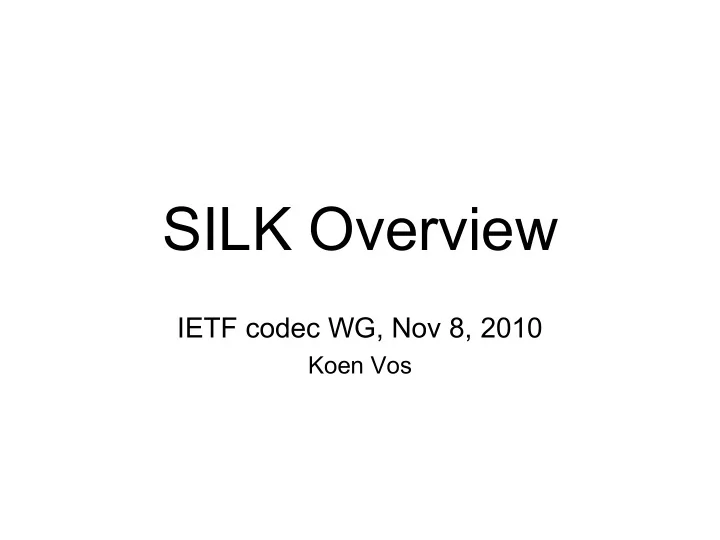

SILK Overview IETF codec WG, Nov 8, 2010 Koen Vos
Decoder
Encoder
Adaptive High-Pass Filter • 2 nd order IIR filter • Cutoff frequency between 80 and 150 Hz • Depends on: – Recent pitch lags: higher cutoff for high pitch frequencies – Noise levels: higher cutoff for noisy input
Prediction • Short-term (LPC) + long-term (LTP) • Re-estimate LPC given LTP coefficients • Burg's method • LPC coefficients coded as Line Spectral Frequencies (LSFs): multi-stage VQ with entropy coding of indices • Interpolation of LFSs for first 10 ms
Two Noise Shaping Structures ● Moving Average (most commonly used) = + + ⋅ Y ( z ) X ( z ) ( 1 W ( z )) Q ( z ) D ∑ − = n with : W ( z ) w n z = n 1 ● Autoregressive = + − ⋅ + Y ( z ) X ( z ) ( Y ( z ) X ( z )) W ( z ) Q ( z ) ⇔ Q ( z ) = + Y ( z ) X ( z ) − 1 W ( z ) D ∑ − = n with : W ( z ) w n z = n 1 Note: for simplicity, quantization noise is treated as an independent, additive signal.
With Prediction Q ( z ) = + Y ( z ) X ( z ) − 1 W ( z ) • Predictor P(z) does LPC and LTP • Noise shaping filter W(z) performs short-term and long-term noise shaping • Setting W(z) = 0: closed-loop predictive quantizer adds white noise • Setting W(z) = P(z): the quantizer becomes open-loop, P(z) determines noise • In practice: something in between Note: some high-rates assumptions were made.
Combined Prediction and Noise Shaping = ⋅ − ⋅ + ⋅ + Y ( z ) G ( 1 W ( z )) X ( z ) W ( z ) Y ( z ) Q ( z ) 1 2 ⇔ − 1 W ( z ) 1 = ⋅ + Y ( z ) G 1 X ( z ) Q ( z ) − − 1 W ( z ) 1 W ( z ) 2 2 ● Quantization noise is shaped by W2(z) ● Input is pre-filtered by (1-W1(z))/(1-W2(z)), and scaled by G`
Entropy Coding of Excitation • Coded per 16-sample block • First compute sum of absolute values • Then recursively split the block in half, each time entropy coding the sum of absolute values in each half • Signs of non-zero samples coded separately • For large signal, LSBs are coded separately
Recommend
More recommend